|
The college has put a large
amount of study and effort into creating an ag learning environment
that will benefit students interested in ag careers. Education can
stop at HCC or prepare students for transfer to higher education
institutes.
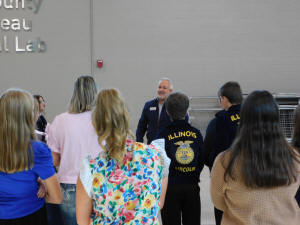
The tour throughout the
complex was guided by Vice President of Development and Community
Engagement Chris Downing. During the tour he told the students that
last year there were 110 ag jobs that were unfulfilled in the area
because there was a lack of qualified individuals to fill the
positions. He said they were well paid jobs, many with starting
salaries above $50,000 per year. He said the education received at
HCC would have met those qualifications.
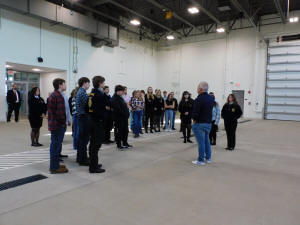
Downing said that in designing
the complex, HCC had consulted with industry experts to get a bigger
picture of what was needed in the classroom environment in order for
students to benefit the most. He noted as an example the shop area
where students can get hands on experience with farm equipment
mechanics. The shop has overhead doors that can be opened, and
equipment driven into the shop area. Downing said that experts had
been given a tour of the shop area and one noted that the door was
not sufficient for modern tractors.

Downing said that had been taken
into consideration in the design and that any tractor on the market
today would fit through the door. However, the expert said that
within the next three years there will be tractors that are
considerably larger than what is available today. Therefore, perhaps
in as little as 12 months the doors in the plan were not going to
work. Downing said that bit of expertise had made a big difference
in the design of the shop and plans were modified so that now, HCC
feels confident that the shop area will accommodate farm equipment
size changes until at least 2028.
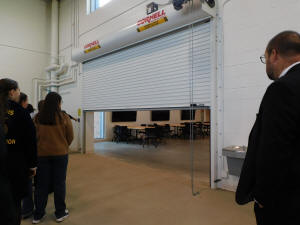
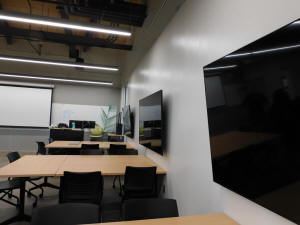
Downing said that while some
aspects of the complex appeared to be there for dramatic effect,
which was cool, the real asset was access to the tools needed to
further education. As an example, he pushed the button to a
secondary overhead door, that opened into a classroom setting with
large screen monitors on the walls and workstation tables set at
each monitor.

Downing said that the room was designed to accommodate viewing of
diagrams and diagnostic information for vital areas of piece of
equipment but was also used for other interactive education. He
noted that within the complex, most of the learning areas are not
traditional desks all in a row forward facing, but are rather
designed for workgroups and hands-on education.
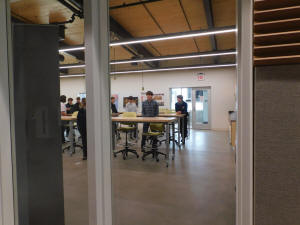
Exiting the far door, the next
stop was the tech lab. Here again, stations are set up to
accommodate two person teams and is an area where students will
learn about soil analysis and plant analysis.
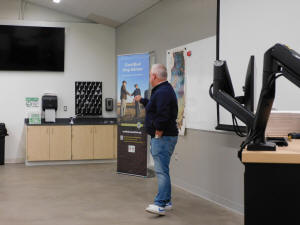
While in this room, Downing
spoke about a career that can be obtained through the knowledge
gained in the tech lab, that of a certified crop adviser.

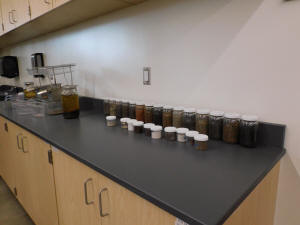
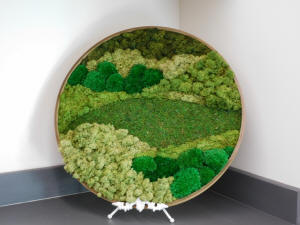
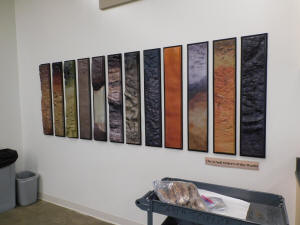
Learning in this room can
include soil analysis and plant analysis, both of which are
important components of the crop adviser career.
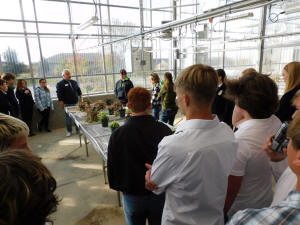
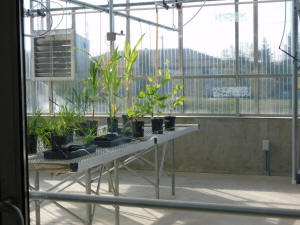
Next, the tour moved into the
greenhouses that are attached to the building on the south side.
Downing said first of all, that the greenhouses were facing south,
but also facing Raab Road, the main thoroughfare moving past
Heartland College. He said that putting the greenhouses in this
location was intentional as HCC wanted the greenhouse to signify to
the community what this building was all about. He said that the
glass structures could have been placed elsewhere and been as
effective in the learning experience, but putting them on the road
side of the building was a clear statement to the public.

The last area the students visited was a traditional face-forward
lecture style classroom. Downing said that this room would be used
for a variety of classes including some that were not necessarily ag
focused, but with a hitch. He said for example the room will be used
for essay and speech-oriented classes for any focus of study at the
college, but the hitch would be that in this room, everything
written or spoken would have to have an agricultural theme.
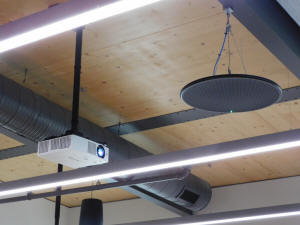
Downing also pointed out that
in this room like others, there are projection screens with overhead
projectors and excellent sound systems.
When the tour was over, the class headed outside to conduct ribbon
cuts for a special yard ornament at the complex.
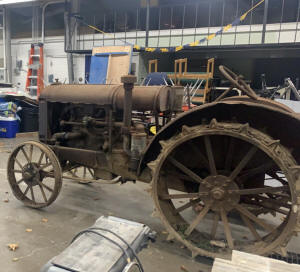
In 2021 the Lincoln Community
High School FFA received a donation of a 1927 McCormick-Deering
10-20 tractor from Dave Bishop of Prairie Earth Farms in Atlanta.
Bishop gave the group the tractor in a very ill state, worn down,
rusted, and in general looking like it might be time for the scrap
yard. Students spent the next three class years working on the
tractor and restoring it to its original beauty.
The work began under the instruction of FFA advisor Allie Bode’ and
was completed under the direction of LCHS Ag teacher and FFA adviser
Molly Schempp.
[to top of second column]
 |

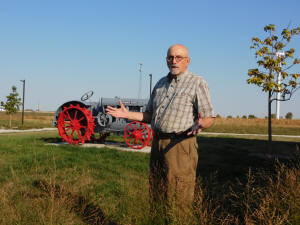
On Friday, Bishop, who is also
an ag instructor at Heartland spoke about the history of the
tractor. He said that the 1927 was among the first tractors to take
the American farmer out of the horse age and into the age of
mechanical power. He said it was a steep learning curve and not
without some disastrous challenges.
Bishop said that some of the specific instructions, such as “slowly
let up on the clutch,” did not sink in well with farmers. Therefore
they would set the clutch, put the tractor in gear, pop the clutch
and kill the engine. It was a frustrating experience for the
operator but also a dangerous one, because, many times, in
frustration, the farmer would jump off the tractor and go to the
front of the tractor to the hand crank that would re-start the
engine without taking the tractor out of gear. Thus when they turned
over the engine with the crank, the tractor would move, sometimes
running over the farmer.
Bishop concluded saying that
it was fitting that the old tractor stood facing the new complex,
that it was a statement of “here’s where we came from, and here is
where we are going.” He said that 1927 was a year of change, but
there are even more changes on the horizon and that the agriculture
industry will need the best and the brightest minds to keep it
moving in the right direction. He encouraged each student present to
consider furthering their education in agriculture.
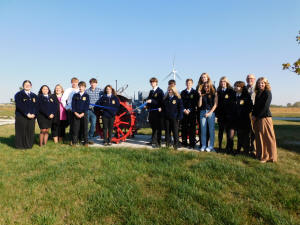
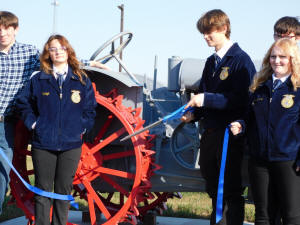
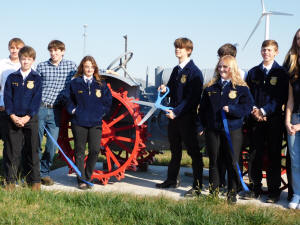
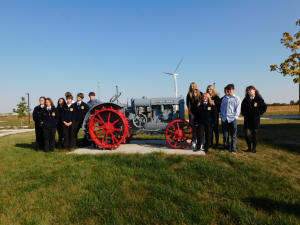
When Bishop was finished there
were a series of ribbon cuts starting with the FFA members who had
actually worked on the tractor. About half of the youth present
lined up around the tractor with Matthew Sebastian doing the honors
of snipping the ribbon.
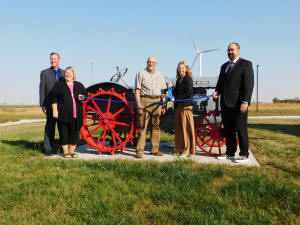
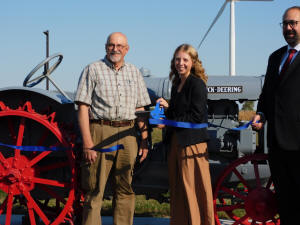
Next us was a ribbon cut with
LCHS staff and Bishop. Those participating in that cut were LCSH
District 404 Superintendent David Stricklin, Business Teacher Joan
Dahmm, Bishop, Schempp, and LCHS Principal David Helm. With Schempp
being the one to cut the ribbon.
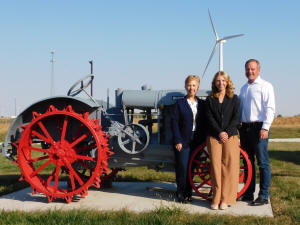
There was also a photo taken
of Schempp and her parents Darin and Cindy. Darin Schempp has done a
great deal of work in the area of restoration and custom paint, and
helped guide the students through the final process of restoring the
tractor.
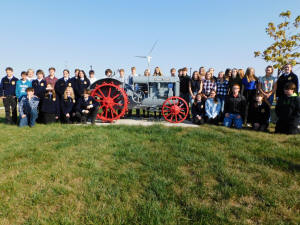
The final photo included all
the students involved in the 2024-25 school year FFA program at LCHS.
When the photos were completed, Schempp provided three students for
LDN to speak with one on one. Matthew Sebastian, Reece Entwistle,
and Oliver White all spent a great deal of time with the tractor,
working on it during class time, and spending many a lunch hour in
the shop cleaning rust off of parts and getting it tractor ready to
put back together.
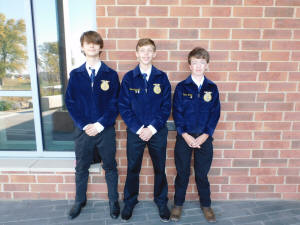
All three boys are sophomores
this year and had the privilege along with several other class
members of being the ones who got to see the final product all put
back together and looking as good as the day it was first
manufactured.
Sebastian said that when they came in last year, the tractor was
disassembled and laying in parts and pieces. Every piece was rusted
and dirty and everything had to be thoroughly cleaned up before it
was out back together and went to paint.

White said to him that was the best part of the work. He very much
enjoyed working to clean the various pieces and gained satisfaction
from having them at their very best before reassembly.
Entwistle said his greatest take away from the project had been the
relationships he built with others who worked on the tractor. He
said for example, as a freshman, he had no classes with White and
met him in FFA. The two have become friends and that would not have
happened otherwise. He added that working on the tractor gave him
new perspectives and insights on life in general.
Both White and Entwistle come from farm families and have an
interest in going forward in agriculture. Entwistle said his plan is
to become a veterinarian. White will also stay in the farming
industry. Sebastian said he does not come from a farm family, but
his dad owns a repair shop in Manito, so he may be interested in
incorporating agriculture and mechanics into his future.

Schempp also spoke briefly to LDN saying that while she was the
teacher getting credit for the completion of the tractor, her
predecessor Allie Bode’ had led her students through a large part of
the project. She said she wanted Bode’ and the classes that she led
to be recognized as having made a big contribution to the bringing
the tractor back to its former glory.
Sebastian also said that try as they might, the tractor never ran.
He said that the front crank starter was seized up so badly that the
class tried everything short of a sandblaster to get it to break
loose, but it never did.
The final paint work was completed on the tractor on April 8th
according to White. Then it was transported to Heartland Community
College and presented to the school for the ag complex.
When all the outdoor photo ops were completed, the class was taken
back inside the complex where they would hear a presentation about
Heartland College in general and be treated to lunch courtesy of the
college.
Related articles from Lincoln
Daily News archives
05/18/2024 - Lincoln FFA completes three-year antique tractor
restoration project
https://archives.lincolndailynews.com/
2024/May/18/NEWS/today051824_
TRACTOR.shtml
08/11/2024 - Antique Tractor display unveiled at Heartland Community
College Ag Complex
Tractor donated by Logan County resident, restored by LCHS FFA
https://archives.lincolndailynews.com/
2024/Aug/12/NEWS/today
_BISHOP.shtml
|